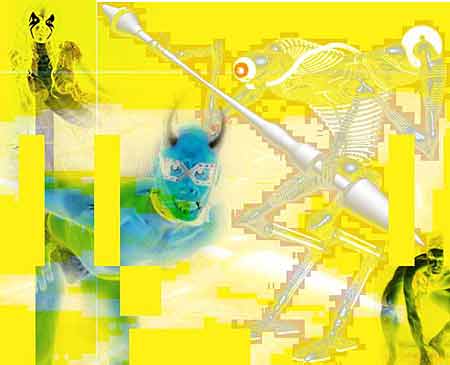BY LETTER
Memetic Demons
The darker side of memetic totems |
 Image from Bernd Helfert |
Memetic Demons are self-perpetuating patterns which use mental and social processes as their hardware and software, propagating ideas and belief systems with negative social and psychological effects.
Where - as standard totemic memes often work to attain the best for all sentients they come in contact with, or at least maintain an equilibrium (happiness vs. suffering, life vs. death), memetic demons seem to promote their own group or cause at the expense of all others. This may include any number of clever and insidious behaviors that either attack sentients external to the group or coerce the initiation of individuals reasoned to be "strong" in some regard. Some would argue that whether a self-conscious meme is an angel or demon is a matter or perspective. But there are definitely commonalities between self-conscious memes that are held to be "demons" or "angels". It should also be stressed that the consciousness of a self-conscious meme lies not in the individuals so much as the group. Although having many individuals separated for long periods of time does take its toll on a totemic meme, they often recruit new members to replace their departed ranks. Also, it is not totally impossible for individuals to wrestle with the totemic meme for control or even personally disregard the totem completely.
Just as each mind involved at one time in a memetic totem can be a potential seed for a new totem, so too are there "demon seeds" waiting in various individual notes of conscious (brains, etc.) to be wreaked upon an unsuspecting group.
Related Articles
- Cryptomemegineering
- Cryptomemetic Index - Text by M. Alan Kazlev
The degree to which an engineered meme cannot be detected, even by conventional memetic analysis. It is based on a complex of factors, most of which are incomprehensible to subsingularitan sophonts. - Infection Strategy - Text by Glenn Grant
Any memetic strategy that encourages infection of a host. Jokes encourage infection by being humorous, tunes by evoking various emotions, slogans and catch-phrases by being terse and continuously repeated. Transapient-initiated memes have incredibly subtle (to ordinary sapient) strategies, sometimes not even recognised as memes by their targets. There are also transingularitan (transapient) strategies that ordinary sapienst are immune to by virtue of their lack of receptivity (see replication strategy; mimicry). - Infection, Memetic
- Membot, Memebot
- Meme
- Meme Bug - Text by M. Alan Kazlev
A sentient being modified to memetically infect higher toposophics. May be malicious or harmless. Meme Bugs are usually subsapient, but there are also sapient and even transapient variants. Their whole purpose is tied up with carrying the meme and infecting the target. Some types of Madverts are Meme Bugs that have been reversed engineered and given a different payload. - Meme Mule - Text by M. Alan Kazlev
A type of memenger, a sophont modified to transport memes from one place to another, but who is not aware of the purpose of the memes e carries. Often the memes are of a higher toposophic level than the mule emself. While having a strong sense of duty and service to the transapient or archailect on whose behalf they are transporting the memes, Meme Mules are not themselves affected by the memes they carry. They may unload the memes via docking stations (DNI upload), or even through their unconscious actions may trigger the desired responses in the target society or environment. - Meme Pool - Text by Glenn Grant
The full diversity of memes accessible to a culture or individual. Learning languages and traveling are methods of expanding one's meme pool. - Meme-complex, Memeplex - Text by Glenn Grant
Also sometimes called a memeticity. A set of mutually-assisting memes which have co-evolved a symbiotic relationship. Religious and political dogmas, social movements, artistic styles, traditions and customs, chain letters, paradigms, languages, and so on are meme-complexes. Types of co-memes commonly found in a scheme are called the: bait; hook; threat; and vaccine. A successful scheme commonly has certain attributes: wide scope (a paradigm that explains much); opportunity for the carriers to participate and contribute; conviction of its self-evident truth (carries Authority); offers order and a sense of place, helping to stave off the dread of meaninglessness. - Memegeneer
- Memetic Infector - Text by M. Alan Kazlev
A sapient being used to infect societies or communities with a particular memeset. Memetic infectors resemble ordinary sophonts, but may differ psychologically, often having fanatical or one-sided enthusiasm for the meme-plex they are carrying. Infectors may be replicators (viruses) or non-replicators (memengers). - Memetic War - Text by M. Alan Kazlev
A war of ideology and persuasion rather than weaponry or military might. Most transapients and archai uses memetics when dealing with lower toposophics and subsingulitaritans, few resort to anything as crude as actual hardware or software weaponry. Examples of memetic warriors might be PR agents, priest, poets, empaths. - Multipart Memetic Assault
Appears in Topics
Development Notes
Text by Peter Kisner
Initially published on 08 December 2001.
Initially published on 08 December 2001.






